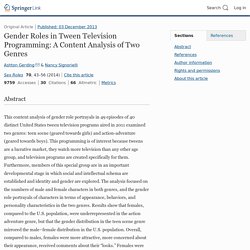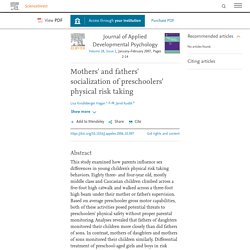

What is the difference between sex and gender? Definition. Gender stereotypes. Effect of gender stereotypes on children. Males were shown in varying levels of attractiveness and were portrayed more stereotypically in the action adventure shows. Tween viewers could narrow conceptions about their range of possibilities in society. Aaron Stone. (2013).

Retrieved from J., & Harrison, K. (2004). The gender-role content of children’s favorite television programs and its links to their gender-related perceptions. Media Psychology, 6, 111–146. doi:10.1207/s1532785xmep0602_1.Article Google Scholar Baker, K., & Raney, A. (2007). Equally super? : Gender-role stereotyping of superheroes in children’s animated programs. Animating Gender Roles: How Disney is Redefining the Modern Princess - Disney has shifted into the Progression period, which is an opportunity to shatter the glass ceiling and push past traditional gender roles for women. Kids' assumptions are turned around at career day in school. Gender Roles and Stereotypes starts from childhood. How Parents Influence Kids' Gender Roles.
Definition of gender identities. The revolutionary truth about kids and gender identity. How do children typically express their gender identity? Definition of social learning theory. Social Learning Theory applied to children's gender development. Girl toys vs boy toys: The experiment - BBC Stories. How does gender role identity develop in children? Examples of how children learn their gender roles through differential reinforcement. Disney Female Stereotypes. The Damsels in Distress We see the "damsel in distress" theme featured in the early Disney princess movies.

Snow White, Cinderella, Aurora, Ariel, and Belle are all searching for their true love and waiting to be saved by a prince charming. Children's Books Enforce Gender Stereotypes. Gender stereotypes and education in children. They start to shape their preferences and career paths. How does differential reinforcement affect the children's gender identity? How parents influence sex differences in their children's physical risk taking behaviors. Abstract This study examined how parents influence sex differences in young children's physical risk taking behaviors.

Eighty three- and four-year old, mostly middle class and Caucasian children climbed across a five-foot high catwalk and walked across a three-foot high beam under their mother or father's supervision. Based on average preschooler gross motor capabilities, both of these activities posed potential threats to preschoolers' physical safety without proper parental monitoring. Analyses revealed that fathers of daughters monitored their children more closely than did fathers of sons. In contrast, mothers of daughters and mothers of sons monitored their children similarly. 'Boys shouldn't act like girls and girls shouldn't act like boys' Carter, D.

B., & McCloskey, L. A. (1983–1984). Peers and the maintenance of sex-typed behavior: The development of children's conceptions of cross-gender behavior in their peers. Social Cognition, 2, 294-314. Children Develop Gender Identities Through Observational Learning. How Media Reinforce Gender Roles. Objectifying Media: Their Effect on Gender Role Norms and Sexual Harassment of Women - Silvia Galdi, Anne Maass, Mara Cadinu, 2014. How have gender stereotypes changed over time and what can we do to help our children find their gender identity?
How do I teach my kids about gender? Note for parents to be able to assist children to better develop activities and behavioral habits such that gender-related stereotypes fail to develop.